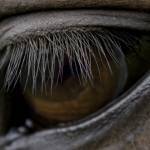Cushing’s Disease Can Affect Eyes of Horses

Equine Cushing’s disease, or pituitary pars intermedia dysfunction, is common in older horses and is suspected when a horse shows the classic signs of a long, thick hair coat that refuses to shed. Horses with Cushing’s disease may also have abnormal fat deposits, increased thirst and urination, and a tendency to develop laminitis more easily than normal horses.
According to new research conducted at the University of Pennsylvania, these horses also have reduced nerve sensitivity in their corneas. While this element of Cushing’s disease doesn’t cause eye problems itself, it’s something owners need to be aware of so they can watch carefully for inflammation or injuries.
The cornea is a transparent outer layer of tissue that covers and protects the eye. Even in horses that don’t have Cushing’s disease, nerves in the cornea become somewhat less sensitive to irritation and pain as horses age. This same change occurs in Cushing’s horses, but the decrease in sensitivity is much greater. Nerves in the cornea don’t react normally, the eye doesn’t show signs of irritation, and natural healing of small defects doesn’t occur.
If the cornea is irritated by dust, infection, or a scratch or cut, a horse’s body should react by increasing the production of tears. The affected horse will partly close the eye and will resist having the area examined. With reduced sensitivity, owners may not see these signs and may not be aware that the horse has an irritated eye until the condition has progressed, sometimes to the point that treatment isn’t effective.
Cushing’s disease can be treated, but can’t be cured, so this decrease in corneal sensitivity is something that owners of affected horses should be aware of. The horse’s eyes should be checked every time the horse is groomed, with owners watching for any sign of tearing, redness, mild squinting, a cloudy appearance in the cornea, or other indications of irritation. With early treatment by a veterinarian, minor problems can often be cleared up before they become more serious.








